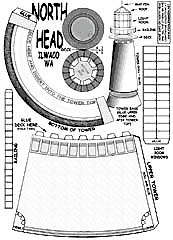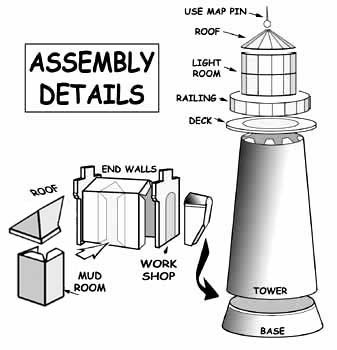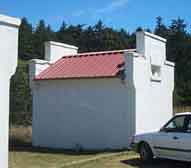

North Head, WA - $$4.95
Ships approaching the treacherous mouth of the Columbia River were not able to see the Cape Disappointment Lighthouse in time to stay clear of the rocky coast and currents. After many costly wreaks, the Lighthouse Service, in 1898, built a 65-foot tall conical tower facing the ocean north of the cape.
North Head Lighthouse at Ilwaco, Washington
 Ships approaching the treacherous mouth of the Columbia River were not able to see the Cape Disappointment Lighthouse in time to stay clear of the rocky coast and currents.. After many costly wreaks, the Lighthouse Service, in 1898, built a 65-foot tall conical tower facing the ocean north of the cape. Its light is 194 feet above the water, visible 20 miles out.
Ships approaching the treacherous mouth of the Columbia River were not able to see the Cape Disappointment Lighthouse in time to stay clear of the rocky coast and currents.. After many costly wreaks, the Lighthouse Service, in 1898, built a 65-foot tall conical tower facing the ocean north of the cape. Its light is 194 feet above the water, visible 20 miles out.This beautiful Lighthouse is still in service (automated) and open for visitors. To view and photograph the North Head Lighthouse, follow the signs to Fort Canby.

North Point Lighthouse at Ilwaco, Washington

North Head (1898) On 3 November 1891, the British ship Strathblanei rammed ashore between Ocean Beach and Cape Disappointment, with the tragic loss of six of the crew. The misfortune was just one of repeated disasters along the sandy North Beach peninsula which made it increasingly evident that the trusty Cape Disappointment Light, for all its worth, was too often ineftective. All adjoining headland blocked the lighthouse's rays to the north, preventing them frorm warning mariners approaching from that direction.
In 1893, the Lighthouse Board requested funds for a second lighthouse at the mouth of the Columbia River-a first-order light on North Head, two miles north of Cape Disappointment. Congress responded with $25,000, which funded a 65-toot masonry tower on the west side of the promontory. The white brick structure, sheathud with a cement plaster overlay, rests on a sandstone foundation.
To provide North Head with the strongest possible illumination, officials assigned to it the first-order Fresnel lens that formerly brightefled Cape Disappointment Light. Fashioned in 1822, the muchtraveled optic had originally served at the Highlands (Navesink) twin lights station in New Jersey.
North Head Light was activated 16 May 1898. Emanating from an exposed, 125-foot bluff-winds here were once clocked at 150 miles per hour-the fixed white beams could be seen 20 miles ir, clear weather.
The classic lens served until 1937, when it was replaced with a fourth-order optic which, in turn, gave way (13 years later) to two revolving searchlights. Both Fresnel lenses survive. The original is displayed at Fort Canby's Lewis and Clark Interpretive Center, while its successor reposes at the Columbia River Maritime Museum in Astoria .
The Coast Guard automated North Head Light in 1961, when it removed the keepers from the two dwellings east of the light. Today, the buildings serve as residences for Fort Canby staff.

 Winds
are often extreme at North Head and for several years a weather
station located there frequently clocked winds of over 100 mph.
On occasion, trees were flattened and chimneys and fences were
knocked down. The gloom of winter once overcame the wife of a
lighthouse keeper there, and she committed suicide by hurling
herself off the precipitous cliff near the tower.
Winds
are often extreme at North Head and for several years a weather
station located there frequently clocked winds of over 100 mph.
On occasion, trees were flattened and chimneys and fences were
knocked down. The gloom of winter once overcame the wife of a
lighthouse keeper there, and she committed suicide by hurling
herself off the precipitous cliff near the tower.
The principal keeper reported in the station journal on April 19, 1932 that a wild duck, in dive bomber fashion, crashed through the plate glass of the lantern house and took a small chip out of the lens. The wardens of the light allegedly had a duck dinner that night.
Northward from North Head is finger-like North Beach Peninsula, an unusual barrier of sand bordered on one side by the Pacific and on the other by Willapa Bay. From Cape Disappointment to Willapa Bay is a straight 22 mile stretch of beach, one of the longest of its kind on the Pacific Coast. Its fringes and outer shoals are littered with the bones of wrecked ships, some of which appear and again disappear at the whims of the shifting sands and tidal action. North Head Light seemingly stands like a monument over the graveyard of ships that spreads out below its lofty perch, it's powerful flashing revolving beacon warning of the danger all around.
 NORTH
HEAD LIGHT
NORTH
HEAD LIGHT
Ilwaco (1898)
Built in 1898 for $2S,000, the North Head Light station was established to warn ships approaching the Columbia River from the north. The Columbia's extensive bar is very dangerous and has claimed many vessels.
The white tower is sixty-five feet tall and stands at the edge of a cliff almost 130 feet high. Originally fitted with a first-order classic lens removed from the nearby Cape Disappointment Lighthouse, it received a less powerful fourth-order lens in 1930. Nowadays, a rotating aero-marine beacon serves here.
North Head is said to be the windiest spot in the nation. Winds blast across the narrow peninsula at speeds that have been clocked at 150 miles per hour. Trees, chimneys, and fences have been flattened in the gale force winds. In 1932 a wild duck, blown off course by the wind, smashed into the lantern, shattering a window and chipping the glass prisms of the lens. The damaged equipment was repaired, but the unfortunate duck was way beyond help.
The 65-foot-tall North Head Lighthouse, designed by German-born engineer C.W Leick, sits on solid basalt more than 190 feet above sea level. The lighthouse initially used a first order Fresnel lens, invented at the turn of the 19th century by Augustin Jean Fresnel. The lens was originally stationed in 1841 at the Navesink Lighthouse in New Jersey. In later years, it moved to lighthouses in San Francisco, Cape Disappointment and North Head. The lens burned five gallons of kerosene per night and produced a light that could be seen 20 miles out to sea. The five-ton lens, purchased for approximately $4,500, would cost $6 million to build today.
A smaller fourth order Fresnel lens replaced the first order lens in 1937. Rotated with electricity, the smaller lens generated a more powerful light and alternately flashed a one-second bright white light every 6.5 and 21.5 seconds. This rotation is a unique characteristic that identifies the lighthouse to passing ships.
A revolving Crouse-Hinds searchlight replaced the Fresnel lens
in 1950 and, in 1998, the present marine rotating beacon light
was installed. The existing light can be seen 17 miles out to
sea.
A Day in the Life of a Lighthouse Keeper
The United States Lighthouse Service was run with military exactness. For example, to reflect the lighthouse keepers' hierarchy, the chandelier in the head keeper's residence had six candles, while the first and second assistants had five and four candles respectively. The keepers were also required to wash laundry on a certain day and received demerits if sheets were hung to dry on the wrong day.
The three lighthouse keepers each worked an eighthour shift to provide 24-hour coverage and ensure that the light remained visible. They carried 30 pounds of kerosene up the stairs, trimmed the wicks and cleaned the lens - the most time consuming task. Lighthouse keepers cleaned off soot and burnt oil from the lens with rags or pieces of softwood, used wine to clean the entire lens every 60 days and polished it with a jeweler's rouge once a year.
When not manning the light, keepers could read books from the portable library, including a new Bible and prayer book issued every quarter.
Women of the Lighthouse
Lighthouse keeping has also touched the lives of women; many who cared for residential households while their husbands managed the lighthouse. One dramatic story tells of a head keepers wife who was "unable to bear the howling of the winds" and flung herself off the cliff into Beard's Hollow.
Another woman, Mabel Bretherton, demonstrated that lighthouse keeping wastA just a mat~s job. She transferred to North Head from the lighthouse in Cape Blanco, Ore., and served as a lighthouse keeper for many years until her resignation in 1907.
Interesting Facts
The Cape Disappointment and North Head Lighthouses are both hinctional and are operated by the U.S. Coast Guard.
North Head Lighthouse's original first order Fresnel lens may be viewed at the Lewis and Clark Interpretive Center.
A U.S. Weather Station sat on the hill above North Head from 1902 to 1955.
North Head is the windiest lighthouse area on the West Coast and the third windiest in the nation. Winds of 120 miles per hour have been recorded at the site.
In 1932, a duck was blown off course, crashed through the lighthouse window and chipped the lens.
In 1788, British fur trader John Meares named the area Cape Disappointment after his inability to locate the river's mouth.
In 1792, Captain Robert Gray named the Columbia River after his ship, the Columbia Rediviva.
(from the Official North Head literature)


